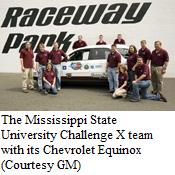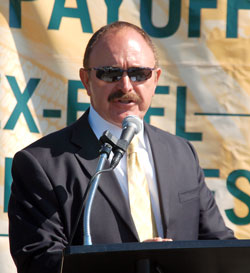 Biodiesel-powered vehicles were the dominating force during this year’s Challenge X… a four-year engineering competition with 17 university teams from across North America developing General Motors vehicles using alternative energies.
Biodiesel-powered vehicles were the dominating force during this year’s Challenge X… a four-year engineering competition with 17 university teams from across North America developing General Motors vehicles using alternative energies.
Drivers pulled up to the U.S. Department of Energy’s headquarters in Washington, D.C. earlier today in the final 400-mile rally for the competition. This press release from GM says a group of Bulldogs from Mississippi State University ending up taking top honors:
 The Mississippi State team designed a through-the-road parallel hybrid electric vehicle powered by a 1.9L GM direct injection turbo diesel engine fueled by bio diesel (B20). It achieved a 38 percent increase in fuel economy over the production vehicle on a modified urban test cycle.
The Mississippi State team designed a through-the-road parallel hybrid electric vehicle powered by a 1.9L GM direct injection turbo diesel engine fueled by bio diesel (B20). It achieved a 38 percent increase in fuel economy over the production vehicle on a modified urban test cycle.
The second place vehicle, engineered by students at the University of Wisconsin is a through-the-road parallel hybrid electric vehicle with a 1.9L GM direct injection turbo diesel engine fueled by B20. Ohio State University was awarded third place for its power-split hybrid electric vehicle powered by a 1.9L GM direct injection turbo diesel engine and fueled by B20.
“I want to congratulate this year’s Challenge X champion, Mississippi State University, and all of the other participants for their innovative designs and applications of advanced clean vehicle technologies,” U.S. Secretary of Energy Samuel W. Bodman said. “This competition is a unique demonstration of how tremendous technological advancements that are occurring at universities across North America can help us achieve a new energy future — one that is cleaner, more sustainable, more affordable, more secure and less reliant on carbon-based fossil fuels.”
A dozen biodiesel-powered vehicles took part in the competition, while hydrogen was another popular fuel source. You can read more about Challenge X at the competition’s web site: www.challengex.org and the GM FastLane Blog.
 The Democratic National Convention in Denver will be fueled with ethanol made from beer waste, thanks to a donation from Molson Coors Brewing Company.
The Democratic National Convention in Denver will be fueled with ethanol made from beer waste, thanks to a donation from Molson Coors Brewing Company. Molson Coors is donating all the ethanol fuel for the fleet of General Motors flex-fuel vehicles to be used for Convention transportation needs. Coors’ ethanol is made from waste beer generated at their brewery in Golden, Colo.
Molson Coors is donating all the ethanol fuel for the fleet of General Motors flex-fuel vehicles to be used for Convention transportation needs. Coors’ ethanol is made from waste beer generated at their brewery in Golden, Colo. 

 The
The  The U.S. House today has passed a measure seen as important because it extends renewable energy production and investment tax credits has cleared its latest hurdle. H.R. 6049, the Renewable Energy and Job Creation Act of 2008, got through the U.S. House by a 263-160 margin.
The U.S. House today has passed a measure seen as important because it extends renewable energy production and investment tax credits has cleared its latest hurdle. H.R. 6049, the Renewable Energy and Job Creation Act of 2008, got through the U.S. House by a 263-160 margin. Biodiesel-powered vehicles were the dominating force during this year’s Challenge X… a four-year engineering competition with 17 university teams from across North America developing General Motors vehicles using alternative energies.
Biodiesel-powered vehicles were the dominating force during this year’s Challenge X… a four-year engineering competition with 17 university teams from across North America developing General Motors vehicles using alternative energies.  The Mississippi State team designed a through-the-road parallel hybrid electric vehicle powered by a 1.9L GM direct injection turbo diesel engine fueled by bio diesel (B20). It achieved a 38 percent increase in fuel economy over the production vehicle on a modified urban test cycle.
The Mississippi State team designed a through-the-road parallel hybrid electric vehicle powered by a 1.9L GM direct injection turbo diesel engine fueled by bio diesel (B20). It achieved a 38 percent increase in fuel economy over the production vehicle on a modified urban test cycle. The 2008 Indy Pace Car corvette wasn’t the only shiny new toy to check out at the giveaway this morning. The
The 2008 Indy Pace Car corvette wasn’t the only shiny new toy to check out at the giveaway this morning. The  I caught up with Indiana Corn’s Mark Walters again, as well as ICMC’s Mike Shuter (pictured), the council’s President and a Frankton, IN farmer. We talked about the new mobile marketing unit, the truth about ethanol as they see it and how IN corn fits into the ethanol industry. You can listen to my interview with Mark and Mike here: [audio:http://www.zimmcomm.biz/epic/shuter-walters-indy.mp3]
I caught up with Indiana Corn’s Mark Walters again, as well as ICMC’s Mike Shuter (pictured), the council’s President and a Frankton, IN farmer. We talked about the new mobile marketing unit, the truth about ethanol as they see it and how IN corn fits into the ethanol industry. You can listen to my interview with Mark and Mike here: [audio:http://www.zimmcomm.biz/epic/shuter-walters-indy.mp3]
 The
The  Taking the 2008 Corvette is fun… and a bit dangerous. Tom Severino will promise you that. Tom is the Vice President and Market Manager of Emmis Indianapolis radio, the parent company of Hank FM. I spoke with Tom about Hank FM’s joint effort with the
Taking the 2008 Corvette is fun… and a bit dangerous. Tom Severino will promise you that. Tom is the Vice President and Market Manager of Emmis Indianapolis radio, the parent company of Hank FM. I spoke with Tom about Hank FM’s joint effort with the  Well winners, really. And no, they’re not the two cute girls to the right. They were so cute though that I had to use their picture. It was Darron Stewart and his two sons that had brought the magic touch from Carmel, IN to a certain red buzzer. The troupe won a 2-year lease to a 2008 Indy pace car corvette at this morning’s special giveaway. The giveaway was the final event in a month-long promotion to raise awareness of ethanol.
Well winners, really. And no, they’re not the two cute girls to the right. They were so cute though that I had to use their picture. It was Darron Stewart and his two sons that had brought the magic touch from Carmel, IN to a certain red buzzer. The troupe won a 2-year lease to a 2008 Indy pace car corvette at this morning’s special giveaway. The giveaway was the final event in a month-long promotion to raise awareness of ethanol.  There’s no question for the
There’s no question for the  Two more biodiesel producers and a marketer have joined the ranks of those that are meeting a strict fuel quality assurance. BQ-9000 is a voluntary fuel quality assurance program, overseen by the National Biodiesel Accreditation Commission (NBAC) and adopted by the National Biodiesel Board and the Canadian Renewable Fuels Association.
Two more biodiesel producers and a marketer have joined the ranks of those that are meeting a strict fuel quality assurance. BQ-9000 is a voluntary fuel quality assurance program, overseen by the National Biodiesel Accreditation Commission (NBAC) and adopted by the National Biodiesel Board and the Canadian Renewable Fuels Association.